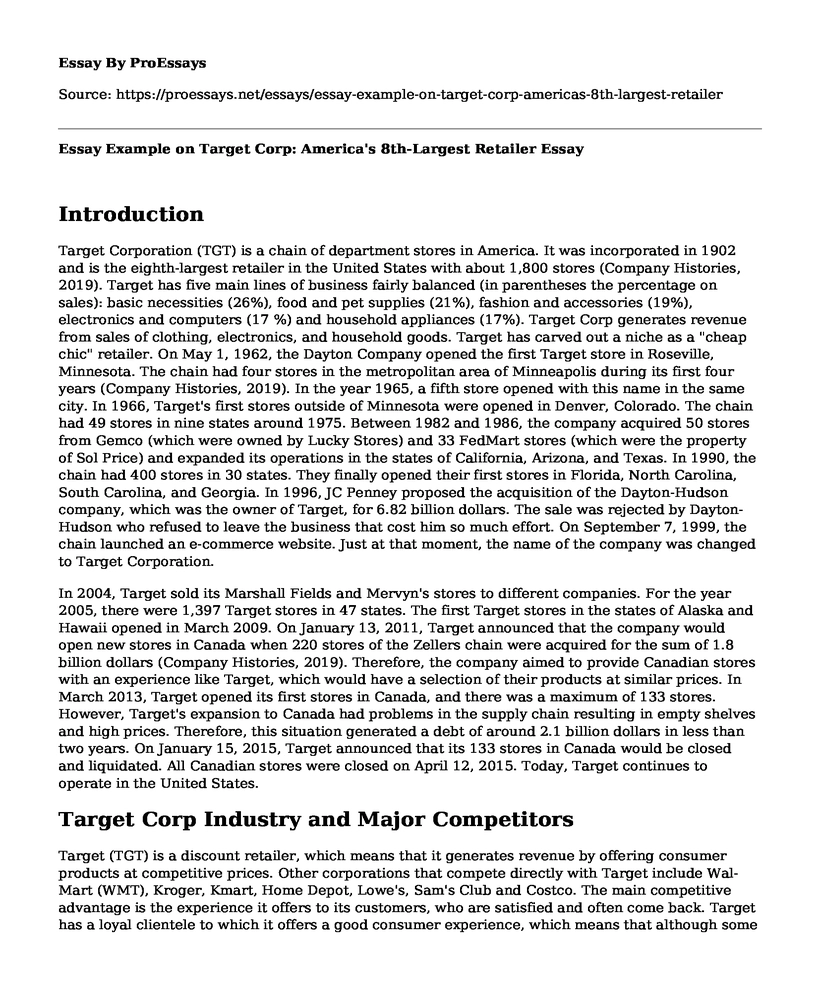Introduction
Target Corporation (TGT) is a chain of department stores in America. It was incorporated in 1902 and is the eighth-largest retailer in the United States with about 1,800 stores (Company Histories, 2019). Target has five main lines of business fairly balanced (in parentheses the percentage on sales): basic necessities (26%), food and pet supplies (21%), fashion and accessories (19%), electronics and computers (17 %) and household appliances (17%). Target Corp generates revenue from sales of clothing, electronics, and household goods. Target has carved out a niche as a "cheap chic" retailer. On May 1, 1962, the Dayton Company opened the first Target store in Roseville, Minnesota. The chain had four stores in the metropolitan area of Minneapolis during its first four years (Company Histories, 2019). In the year 1965, a fifth store opened with this name in the same city. In 1966, Target's first stores outside of Minnesota were opened in Denver, Colorado. The chain had 49 stores in nine states around 1975. Between 1982 and 1986, the company acquired 50 stores from Gemco (which were owned by Lucky Stores) and 33 FedMart stores (which were the property of Sol Price) and expanded its operations in the states of California, Arizona, and Texas. In 1990, the chain had 400 stores in 30 states. They finally opened their first stores in Florida, North Carolina, South Carolina, and Georgia. In 1996, JC Penney proposed the acquisition of the Dayton-Hudson company, which was the owner of Target, for 6.82 billion dollars. The sale was rejected by Dayton-Hudson who refused to leave the business that cost him so much effort. On September 7, 1999, the chain launched an e-commerce website. Just at that moment, the name of the company was changed to Target Corporation.
In 2004, Target sold its Marshall Fields and Mervyn's stores to different companies. For the year 2005, there were 1,397 Target stores in 47 states. The first Target stores in the states of Alaska and Hawaii opened in March 2009. On January 13, 2011, Target announced that the company would open new stores in Canada when 220 stores of the Zellers chain were acquired for the sum of 1.8 billion dollars (Company Histories, 2019). Therefore, the company aimed to provide Canadian stores with an experience like Target, which would have a selection of their products at similar prices. In March 2013, Target opened its first stores in Canada, and there was a maximum of 133 stores. However, Target's expansion to Canada had problems in the supply chain resulting in empty shelves and high prices. Therefore, this situation generated a debt of around 2.1 billion dollars in less than two years. On January 15, 2015, Target announced that its 133 stores in Canada would be closed and liquidated. All Canadian stores were closed on April 12, 2015. Today, Target continues to operate in the United States.
Target Corp Industry and Major Competitors
Target (TGT) is a discount retailer, which means that it generates revenue by offering consumer products at competitive prices. Other corporations that compete directly with Target include Wal-Mart (WMT), Kroger, Kmart, Home Depot, Lowe's, Sam's Club and Costco. The main competitive advantage is the experience it offers to its customers, who are satisfied and often come back. Target has a loyal clientele to which it offers a good consumer experience, which means that although some products are higher than their competitors, people keep going to Target to buy (Bhasin, 2018). It is their way of competing in the sector price war. At Wal-Mart, one can find everything they want: fresh and processed foods, home decor, toys, electronics, clothing, cosmetics, and more. Wal-Mart sells its goods at very low prices and is one of the major competitors of Target. By receiving a huge influx of people, it is common that many things miss at Wal-Mart or dirty, broken, messy shelves, and so on. Target tends to be more organized and enjoyable.
Target and Costco customers have a high income and interest in spending on designer products and high-value goods. Wal-Mart's focus on low prices attracts buyers who typically have lower household incomes than Target and Costco customers. Target typically attracts more affluent customers by highlighting high-quality merchandise and low-cost designer fashion. Costco strategically targets affluent nations, with 41% of Costco's stores located in the ten richest US states (Bhasin, 2018). Buyers in Costco stores are often wealthy and less prone to recession than Target Corp and Wal-Mart customers. Of these three discounters, Costco prefers wealthy customers most often. Target competes directly with Costco for these customers but also strives to compete with Wal-Mart's prices and to position itself competitively among low-income customers.
References
Bhasin, H. (2018). Top 10 Target Competitors. Retrieved from https://www.marketing91.com/target-competitors/ on 19th June 2019.
Company Histories (2019). Target Corporation. Retrieved from http://www.company-histories.com/Target-Corporation-Company-History.html on 19th June 2019.
Cite this page
Essay Example on Target Corp: America's 8th-Largest Retailer. (2023, Jan 23). Retrieved from https://proessays.net/essays/essay-example-on-target-corp-americas-8th-largest-retailer
If you are the original author of this essay and no longer wish to have it published on the ProEssays website, please click below to request its removal:
- Essay Example on US Healthcare Reform: Reducing Uninsured, Affordability and Expansion
- Paper Sample on Walmart: America's Largest Global Retailer & Family-Owned Business
- Essay Example on Fossil Fuels: A Global Challenge for Climate Change
- Free Paper Sample on Missouri Human Rights Act vs Fair Standard Act
- Configuring DHCP Server on Windows Server 2016: Step-by-Step Guide - Report Sample
- International Business Machines Corporation - Report Sample
- Legalizing Marijuana in All States - Essay Sample







